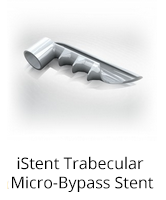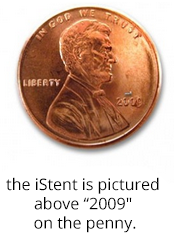Transforming Glaucoma Care with Surgery
Glaucoma care has improved over the years, thanks to advancements in medical technology. Some of the country’s most cutting-edge, transformative glaucoma products and procedures are offered right here at Wilmington Eye. Whether you suffer from mild or acute glaucoma, open-angle or closed-angle glaucoma, our experts can help; treating the symptoms of glaucoma, safeguarding your overall vision, and giving you the freedom to live a life without fear or worry.
While glaucoma is highly treatable, early detection and treatment are key to preventing serious vision loss or blindness from glaucoma. Our board-certified ophthalmic surgeons can provide you with access to the latest and most technologically advanced glaucoma procedures to ensure you receive the long-term results you deserve. From conventional and incisional surgery to implantable devices, our experts can find the right surgical solution for your needs.
iStent® Trabecular Micro-Bypass
Managing your mild-to-moderate open-angle glaucoma can be difficult. Once diagnosed, most patients will spend the rest of their lives putting one, two, or even three different kinds of drops in every day. Unfortunately, all of these drops will not only be inconvenient but also expensive. Wilmington Eye can treat your open-angle glaucoma in a completely new way.
 The iStent Trabecular Micro-Bypass Stent is designed to reduce your eye pressure and you can have it done at the same time you have cataract surgery. The world’s tiniest medical device—iStent—is 20,000 times smaller than the intraocular lenses (IOL) used in cataract surgery and smaller than the individual lettering on a penny. But the size of iStent is only part of its story. By increasing the eye’s ability to drain fluid, this technology is designed to reduce the pressure in your eye.
The iStent Trabecular Micro-Bypass Stent is designed to reduce your eye pressure and you can have it done at the same time you have cataract surgery. The world’s tiniest medical device—iStent—is 20,000 times smaller than the intraocular lenses (IOL) used in cataract surgery and smaller than the individual lettering on a penny. But the size of iStent is only part of its story. By increasing the eye’s ability to drain fluid, this technology is designed to reduce the pressure in your eye.
The world’s smallest medical implant delivers big results in mild-to-moderate open-angle glaucoma.
 While mild-to-moderate open-angle glaucoma is very common, many people are unaware of their condition, especially in the early stages, when their vision may be unaffected. In many people, open-angle glaucoma is characterized by an increase in the intraocular pressure (IOP) of your eye. This pressure is caused by the buildup of fluid within the eye. Too much fluid raises pressure, which can cause the gradual loss of vision. And while glaucoma moves slowly, its damage is irreparable.
While mild-to-moderate open-angle glaucoma is very common, many people are unaware of their condition, especially in the early stages, when their vision may be unaffected. In many people, open-angle glaucoma is characterized by an increase in the intraocular pressure (IOP) of your eye. This pressure is caused by the buildup of fluid within the eye. Too much fluid raises pressure, which can cause the gradual loss of vision. And while glaucoma moves slowly, its damage is irreparable.
How does iStent work?
iStent works like the stents used to prevent heart attacks and strokes. When blood vessels get clogged, a stent creates access to the vessel flow. While a highly innovative technology, how iStent works is elegantly simple:
- If you have glaucoma, over time the eye’s natural drainage system becomes clogged
- iStent creates a permanent opening through the blockage to improve the eye’s natural outflow
- Restoring this mechanism lowers and controls pressure within the eye
Manage glaucoma while treating your cataracts with iStent.
iStent is implanted during your cataract surgery procedure. Once implanted, iStent will begin working to safely and effectively manage pressure. What’s more, patients who receive iStent may experience a reduction in glaucoma medications; but this will be at the discretion of your physician.
Trabeculectomy
If you have glaucoma and medications and laser surgeries do not lower your eye pressure adequately, your eye doctor may recommend a procedure called a trabeculectomy. This procedure is often performed with the use of an anti-scarring medication to reduce the risk of scarring.
During this procedure which is performed in an operating room on an outpatient basis, a tiny drainage opening is made underneath a flap or trap-door of the sclera (white of the eye). The new opening allows fluid from inside the eye to flow underneath the edges of the flap to raise a filtration site within the conjunctiva (outer layer of the eye) called a “bleb”. The bleb is mostly hidden under the eyelid and is often quite low and spread over a large area. The aqueous humor diverted to the bleb then gets re-absorbed by surrounding blood vessels. When successful, the procedure will lower your intraocular pressure (IOP), minimizing the risk of vision loss from glaucoma.
Some of the risks and complications from trabeculectomy surgery include the following:
- infection
- bleeding in the eye
- swelling in the eye
- cataract (in cases where the cataract has not already been removed) and
- decreased or lost vision
- failure to control intraocular pressure, with the need for another operation
- eye pressure that is too low
- irritation or discomfort in the eye
ExPress Mini-Shunt
There is also an option to implant an ExPress mini-shunt under the flap which may reduce the short-term complications of the surgery. There is some evidence suggesting that implanting a stainless steel shunt under the scleral flap through a small opening, avoiding cutting the internal aspect of the sclera or the iris, results in a more predictable early post-operative recovery period. The long-term success appears to be equal but this more stable first couple of months is sometimes worth the extra expense of the shunt in suitable patients.
While some people may experience side effects from medications or surgery, the risks associated with these side effects should be balanced against the greater risk of leaving glaucoma untreated and losing your vision.
Omni Canaloplasty
A canaloplasty is focused on treating a part to the angle called Schlemm’s canal to provide IOP management. This procedure helps to reform Schlemm’s canal, helping it function more adequately to pull fluid off the front of the eye. A thick solution is injected into the canal in a 180- or 360-degree pattern and is then rinsed out to help reform the canal and help provide IOP management.
Kahook Dual Blade
This procedure is referred to as a goniotomy and uses a specialized blade, named for the doctor who invented it. This procedure can be performed along with cataract surgery or independent of cataract surgery and opens the angle further to promote further IOP management. The blade cuts along the trabecular meshwork (a part of the angle) and the resulting incision allows the production and movement of intraocular fluid to function more fully.
Xen Gel Stent
A small stent (though larger than the iStent inject or Hydrus), the Xen Gel Stent is used when a patient’s glaucoma has progressed to a point where aiding or enhancing the angle’s ability to function is not sufficient for IOP and glaucoma management. This stent is placed in the conjunctiva, the white part of the eye, and a stent is fed through the angle to provide an alternative pathway for fluid to drain from the front of the eye and be reabsorbed in the body. The Xen Gel Stent is approximately the length of an eyelash.
Ahmed Tube Shunt
Similar to the Xen Gel Stent, the Ahmed Tube Shunt also bypasses the angle and natural drainage system of the eye to provide IOP management. It is a larger shunt that is placed in the conjunctiva and fed through the angle. This procedure is incredibly effective at IOP management and used in severe stage glaucoma or in patients whose previous surgical intervention has not been effective.
Micropusle CPC
This procedure is used for glaucoma patients who have severe glaucoma and for whom incisional surgery is not recommended. This laser procedure targets the ciliary body (a part of the angle) and destroys a portion to decrease aqueous production and thus reduce IOP. This procedure can last anywhere from 6 months to years and is done in a hospital setting rather than a surgery facility. Whereas the above listed surgeries are focused on outflow management of aqueous, this is the only procedure focused on aqueous suppression.